2015 TOYOTA PRIUS PLUS wheel
[x] Cancel search: wheelPage 431 of 496
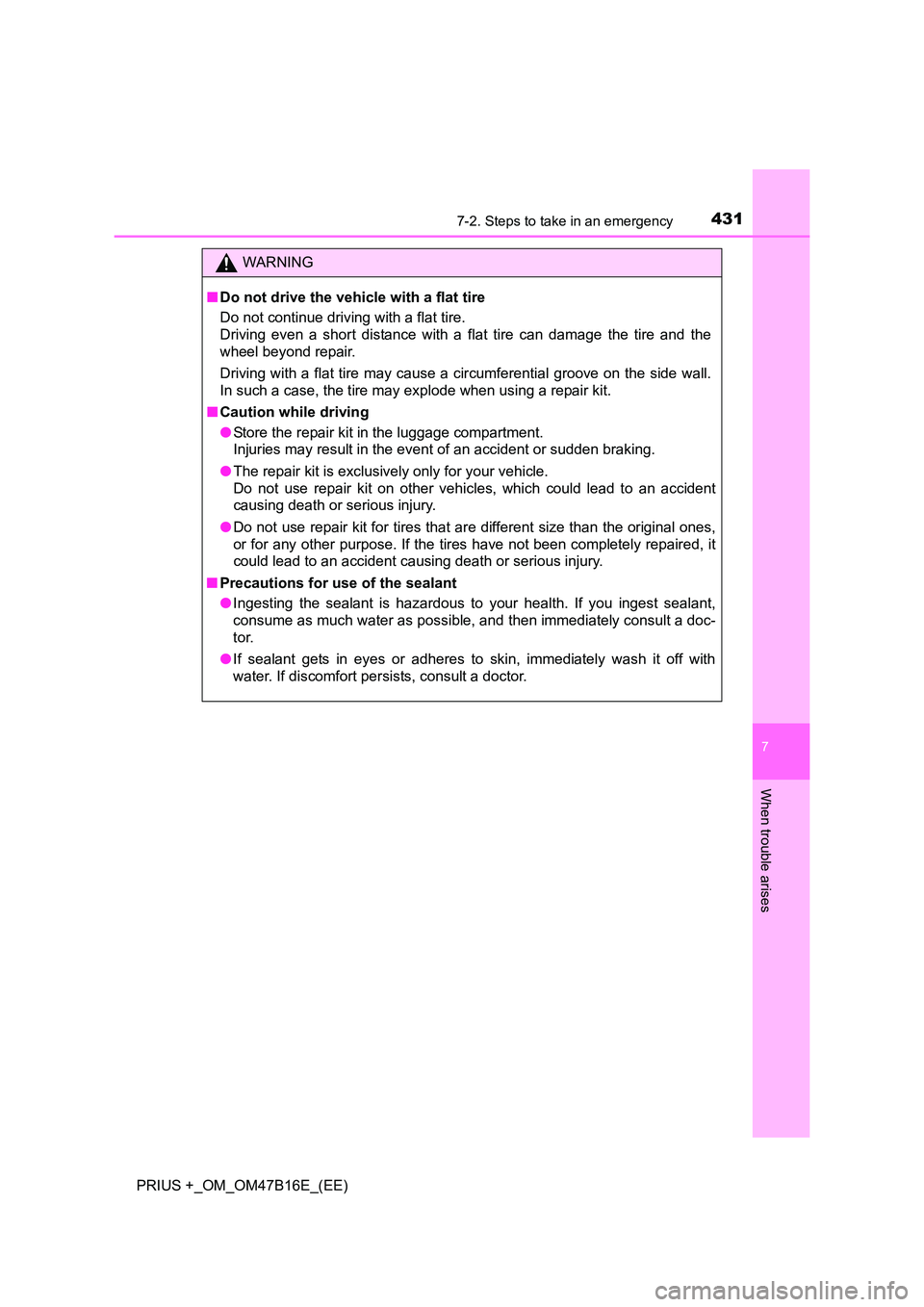
4317-2. Steps to take in an emergency
PRIUS +_OM_OM47B16E_(EE)
7
When trouble arises
WARNING
■ Do not drive the vehicle with a flat tire
Do not continue driving with a flat tire.
Driving even a short distance with a flat tire can damage the tire and the
wheel beyond repair.
Driving with a flat tire may cause a circumferential groove on the side wall.
In such a case, the tire may explode when using a repair kit.
■ Caution while driving
●Store the repair kit in the luggage compartment.
Injuries may result in the event of an accident or sudden braking.
● The repair kit is exclusively only for your vehicle.
Do not use repair kit on other vehicles, which could lead to an accident
causing death or serious injury.
● Do not use repair kit for tires that are different size than the original ones,
or for any other purpose. If the tires have not been completely repaired, it
could lead to an accident causing death or serious injury.
■ Precautions for use of the sealant
●Ingesting the sealant is hazardous to your health. If you ingest sealant,
consume as much water as possible, and then immediately consult a doc-
tor.
● If sealant gets in eyes or adheres to skin, immediately wash it off with
water. If discomfort persists, consult a doctor.
Page 432 of 496
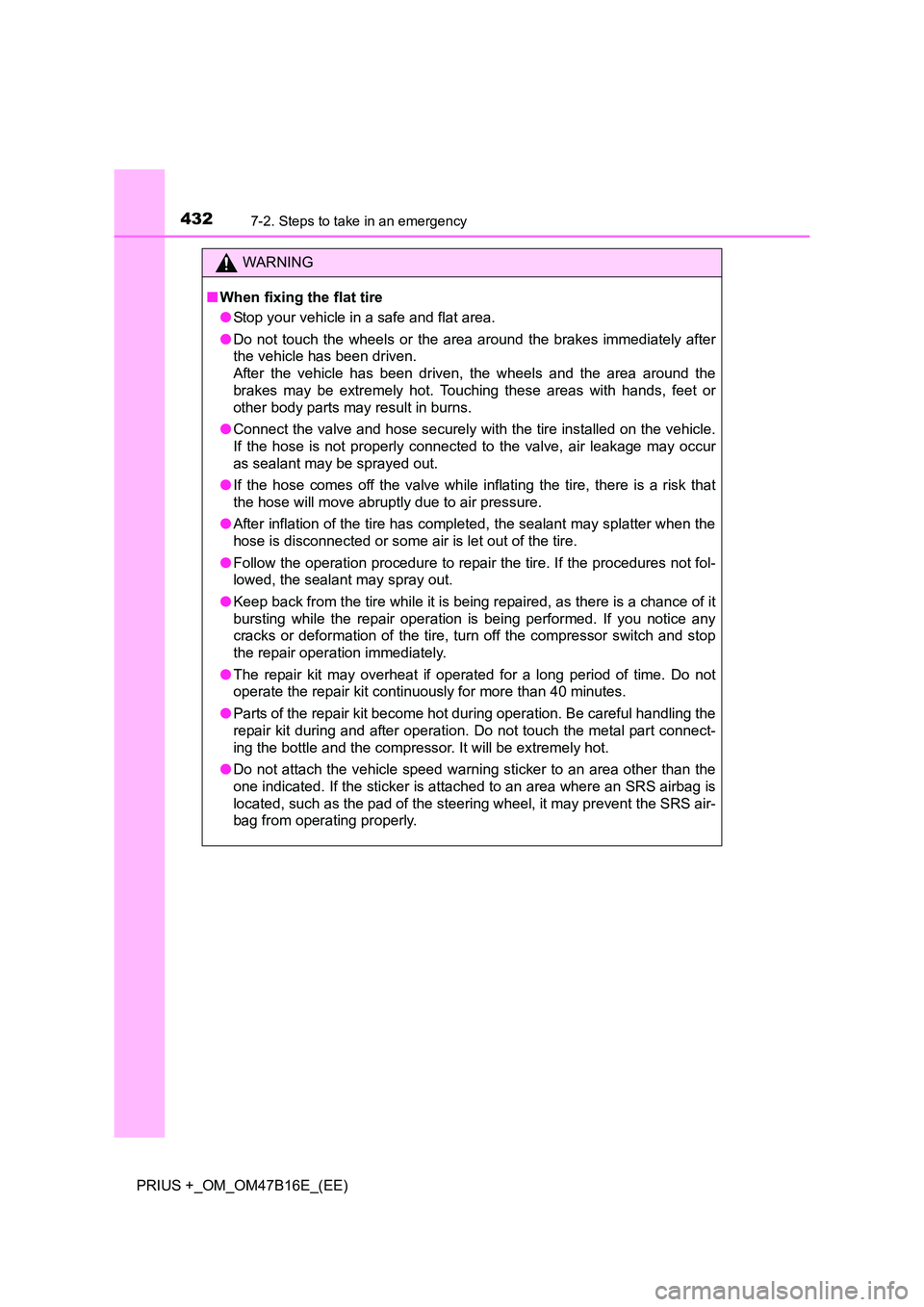
4327-2. Steps to take in an emergency
PRIUS +_OM_OM47B16E_(EE)
WARNING
■ When fixing the flat tire
●Stop your vehicle in a safe and flat area.
● Do not touch the wheels or the area around the brakes immediately after
the vehicle has been driven.
After the vehicle has been driven, the wheels and the area around the
brakes may be extremely hot. Touching these areas with hands, feet or
other body parts may result in burns.
● Connect the valve and hose securely with the tire installed on the vehicle.
If the hose is not properly connected to the valve, air leakage may occur
as sealant may be sprayed out.
● If the hose comes off the valve while inflating the tire, there is a risk that
the hose will move abruptly due to air pressure.
● After inflation of the tire has completed, the sealant may splatter when the
hose is disconnected or some air is let out of the tire.
● Follow the operation procedure to repair the tire. If the procedures not fol-
lowed, the sealant may spray out.
● Keep back from the tire while it is being repaired, as there is a chance of it
bursting while the repair operation is being performed. If you notice any
cracks or deformation of the tire, turn off the compressor switch and stop
the repair operation immediately.
● The repair kit may overheat if operated for a long period of time. Do not
operate the repair kit continuously for more than 40 minutes.
● Parts of the repair kit become hot during operation. Be careful handling the
repair kit during and after operation. Do not touch the metal part connect-
ing the bottle and the compressor. It will be extremely hot.
● Do not attach the vehicle speed warning sticker to an area other than the
one indicated. If the sticker is attached to an area where an SRS airbag is
located, such as the pad of the steering wheel, it may prevent the SRS air-
bag from operating properly.
Page 433 of 496
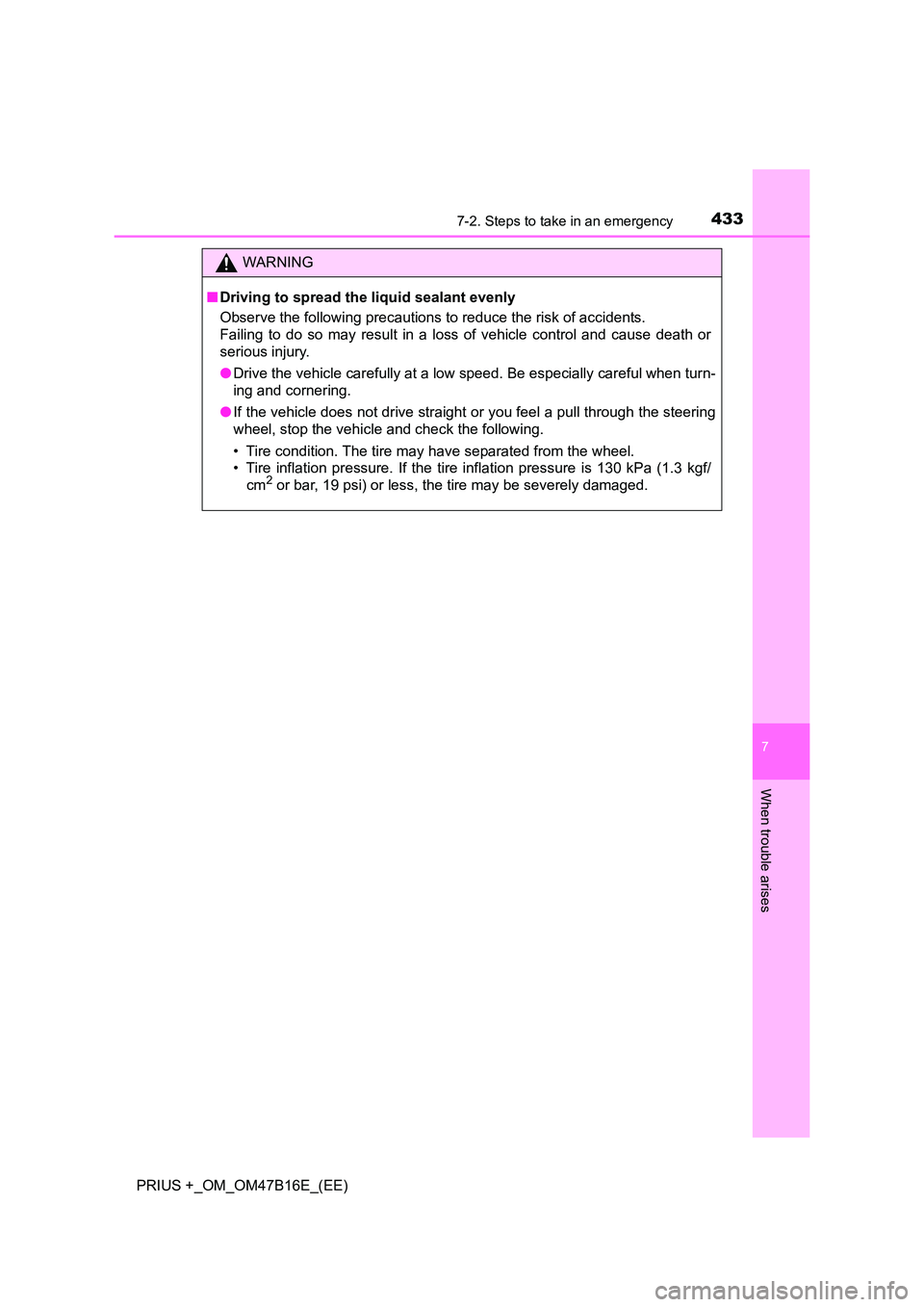
4337-2. Steps to take in an emergency
PRIUS +_OM_OM47B16E_(EE)
7
When trouble arises
WARNING
■ Driving to spread the liquid sealant evenly
Observe the following precautions to reduce the risk of accidents.
Failing to do so may result in a loss of vehicle control and cause death or
serious injury.
●Drive the vehicle carefully at a low speed. Be especially careful when turn-
ing and cornering.
● If the vehicle does not drive straight or you feel a pull through the steering
wheel, stop the vehicle and check the following.
• Tire condition. The tire may have separated from the wheel.
• Tire inflation pressure. If the tire inflation pressure is 130 kPa (1.3 kgf/
cm
2 or bar, 19 psi) or less, the tire may be severely damaged.
Page 441 of 496

4417-2. Steps to take in an emergency
PRIUS +_OM_OM47B16E_(EE)
7
When trouble arises
Start the engine of the second vehicle. Increase the engine speed
slightly and maintain at that level for approximately 5 minutes to
recharge the 12-volt battery of your vehicle.
Maintain the engine speed of the second vehicle and start the
hybrid system of your vehicle by turning the power switch to ON
mode.
Make sure the “READY” indicator comes on. If the indicator light
does not come on, contact any authorized Toyota dealer or repairer,
or another duly qualified and equipped professional.
Once the hybrid system has started, remove the jumper cables in
the exact reverse order from which they were connected.
Close the exclusive jump starting terminal cover, and reinstall the
fuse box cover to its original position.
When installing, first hook the fuse box cover onto the two rear tabs.
Once the hybrid system starts, have the vehicle inspected at any
authorized Toyota dealer or repairer, or another duly qualified and
equipped professional as soon as possible.
■Starting the hybrid system when the 12-volt battery is discharged
The hybrid system cannot be started by push-starting.
■ To prevent 12-volt battery discharge
●Turn off the headlights and the audio system while the hybrid system is off.
● Turn off any unnecessary electrical components when the vehicle is running
at a low speed for an extended period, such as in heavy traffic.
■ When the 12-volt battery is removed or discharged
●The hybrid system may not start. ( →P. 328)
● If the 12-volt battery discharges while the shift position is in P, it may not be
possible to shift the shift position to other positions. In this case, the vehicle
cannot be towed without lifting both front wheels because the front wheels
will be locked. ( →P. 370)
● When the 12-volt battery is reconnected, start the hybrid system and con-
firm that the shift position can be changed to each position using the shift
position indicator.
● Make sure that the key is not inside the vehicle when recharging or replac-
ing the 12-volt battery. The key may be locked in the vehicle if the alarm is
activated. ( →P. 97)
4
5
6
7
8
Page 449 of 496
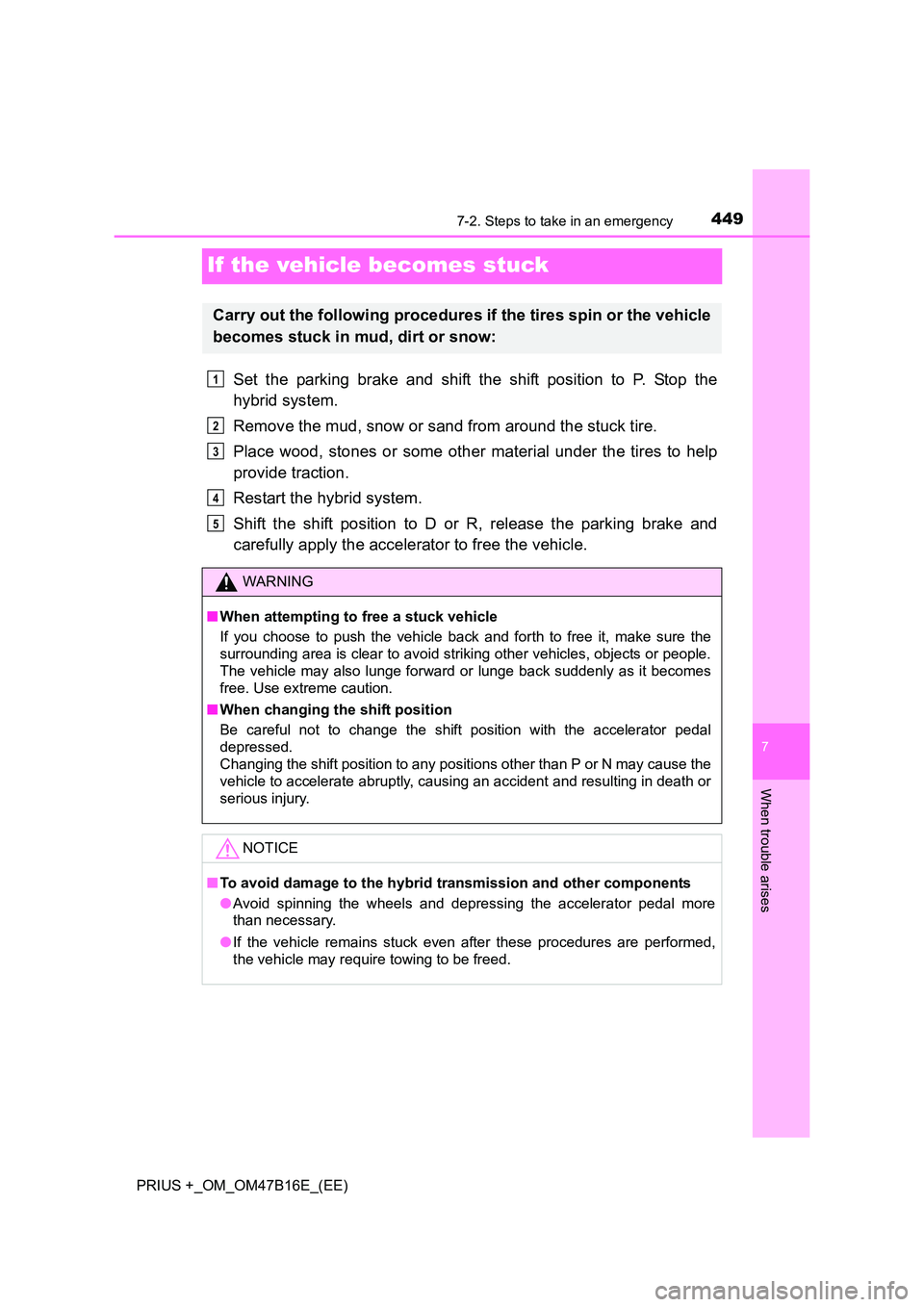
4497-2. Steps to take in an emergency
PRIUS +_OM_OM47B16E_(EE)
7
When trouble arises
If the vehicle becomes stuck
Set the parking brake and shift the shift position to P. Stop the
hybrid system.
Remove the mud, snow or sand from around the stuck tire.
Place wood, stones or some other material under the tires to help
provide traction.
Restart the hybrid system.
Shift the shift position to D or R, release the parking brake and
carefully apply the accelerator to free the vehicle.
Carry out the following procedures if the tires spin or the vehicle
becomes stuck in mud, dirt or snow:
WARNING
■ When attempting to free a stuck vehicle
If you choose to push the vehicle back and forth to free it, make sure the
surrounding area is clear to avoid striking other vehicles, objects or people.
The vehicle may also lunge forward or lunge back suddenly as it becomes
free. Use extreme caution.
■ When changing the shift position
Be careful not to change the shift position with the accelerator pedal
depressed.
Changing the shift position to any positions other than P or N may cause the
vehicle to accelerate abruptly, causing an accident and resulting in death or
serious injury.
NOTICE
■To avoid damage to the hybrid transmission and other components
●Avoid spinning the wheels and depressing the accelerator pedal more
than necessary.
● If the vehicle remains stuck even after these procedures are performed,
the vehicle may require towing to be freed.
1
2
3
4
5
Page 452 of 496
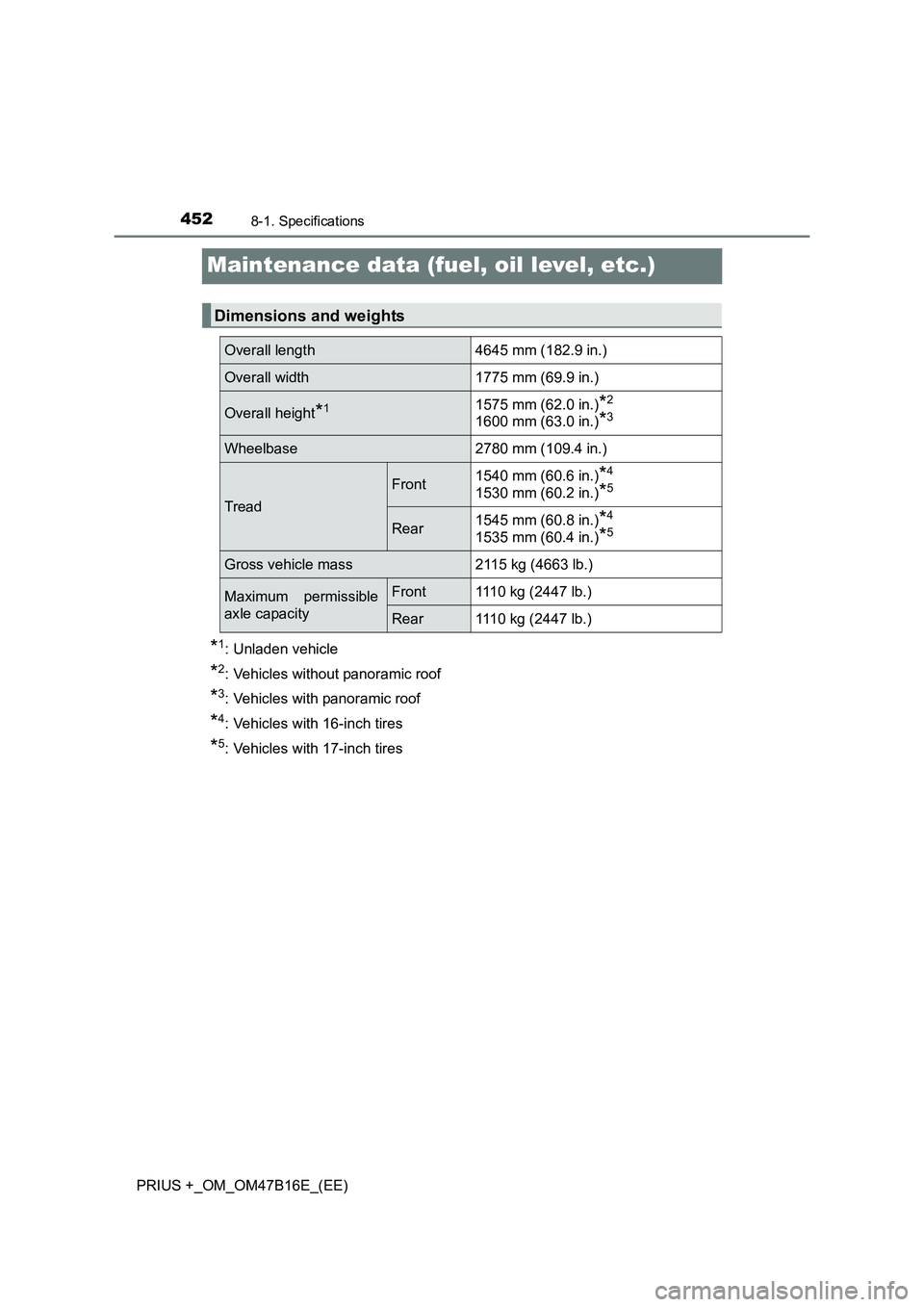
4528-1. Specifications
PRIUS +_OM_OM47B16E_(EE)
Maintenance data (fuel, oil level, etc.)
*1: Unladen vehicle
*2: Vehicles without panoramic roof
*3: Vehicles with panoramic roof
*4: Vehicles with 16-inch tires
*5: Vehicles with 17-inch tires
Dimensions and weights
Overall length4645 mm (182.9 in.)
Overall width1775 mm (69.9 in.)
Overall height*11575 mm (62.0 in.)*2
1600 mm (63.0 in.)*3
Wheelbase2780 mm (109.4 in.)
Tread
Front1540 mm (60.6 in.)*4
1530 mm (60.2 in.)*5
Rear1545 mm (60.8 in.)*4
1535 mm (60.4 in.)*5
Gross vehicle mass2115 kg (4663 lb.)
Maximum permissible
axle capacityFront1110 kg (2447 lb.)
Rear1110 kg (2447 lb.)
Page 461 of 496

4618-1. Specifications
PRIUS +_OM_OM47B16E_(EE)
8
Vehicle specifications
�XTy pe A
�XTy pe B
�XCompact spare tire (if equipped)
Tires and wheels
Tire size205/60R16 92V
Tire inflation pressure
(Recommended cold tire
inflation pressure)
250 kPa (2.5 kgf/cm2 or bar, 36 psi)
Wheel size16 × 6 1/2J
Wheel nut torque103 N•m (10.5 kgf•m, 76 ft•lbf)
Tire size215/50R17 91V
Tire inflation pressure
(Recommended cold tire
inflation pressure)
230 kPa (2.3 kgf/cm2 or bar, 33 psi)
Wheel size17 × 7J
Wheel nut torque103 N•m (10.5 kgf•m, 76 ft•lbf)
Tire sizeT135/70D17 102M
Tire inflation pressure
(Recommended cold tire
inflation pressure)
420 kPa (4.2 kgf/cm2 or bar, 60 psi)
Wheel size17 × 4T
Wheel nut torque103 N•m (10.5 kgf•m, 76 ft•lbf)
Page 480 of 496

480Alphabetical index
PRIUS +_OM_OM47B16E_(EE)
Card holder............................... 288
CareAluminum wheels .................. 301
Exterior.................................. 300
Interior ................................... 305
Panoramic roof...................... 304
Radar sensor ................ 246, 260
Seat belts .............................. 306
Cargo hooks ............................. 289
CD player
*
Chains ....................................... 266
Child restraint system ............... 59 Baby seat definition................. 60
Baby seat installation .............. 68
Child seat definition................. 60
Child seat installation .............. 70
Installing CRS with ISOFIX rigid anchors ......................... 74
Installing CRS with seat belt ... 68
Installing CRS with top strap ... 76
Junior seats definition ............. 60
Junior seat installation ............ 72
Child safety ................................ 58 12-volt battery precautions.... 329
Airbag precautions .................. 48
Back door precautions .......... 148
Child restraint system ............. 59
How your child should wear the seat belt .......................... 42
Installing child restraints.......... 67
Power window lock switch .... 186
Power window precautions ... 188 Rear door child-protectors .... 145
Removed key battery
precautions......................... 352
Seat belt precautions .............. 44
Seat heater precautions........ 279
Child-protectors....................... 145
Cleaning Aluminum wheels.................. 301
Exterior ................................. 300
Interior................................... 305
Panoramic roof ..................... 304
Radar sensor ................ 246, 260
Seat belts .............................. 306
Climate remote control ........... 278
Clock ......................................... 293
Condenser ................................ 324
Console box ............................. 284
Coolant Capacity ................................ 458
Checking ............................... 323
Preparing and checking before winter....................... 265
Cooling system ........................ 323 Hybrid system overheating ... 444
Consumption screen ............... 131
Cruise control Cruise control........................ 227
Dynamic radar cruise control................................. 231
Warning messages ............... 391
Cup holders.............................. 285
Curtain shield airbags ............... 46
Customizable features ............ 465
C